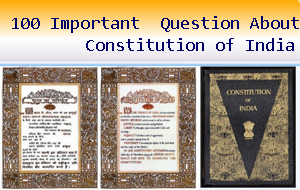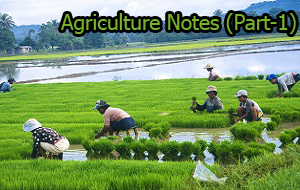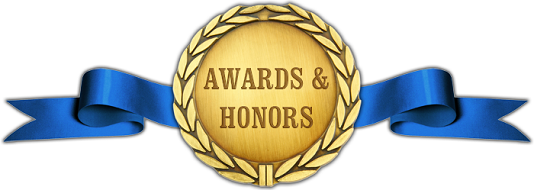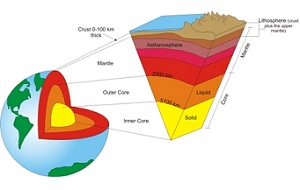
100 Important Question About Constitution of India (Basic) (For Department Of Local Government, Exam)
- The design of the National Flag was adopted by the Constituent Assembly of India in
(a) July, 1947
(b) August, 1947
(c) July, 1948
(d) July, 1950
Answer: July, 1947
- The Constitution of India was enacted by a Constituent Assembly set up
(a) Through a resolution of the provisional government
(b) By the Indian National Congress
(c) Under the Indian Independence Act, 1947
(d) Under the Cabinet Mission Plan, 1946
Answer: D
- A bill in the imperial Legislative Council for compulsory and free primary education was introduced by
(a) Mohammad Shafi
(b) Feroz Shah Mehta
(c) G.K. Gokhale
(d) Shankaran Nair
Answer: G.K. Gokhale
- Who among the folowing was the Chairman of the Drafting Committee of the Indian Constution
(a) Rajendra Prasad
(b) C. Rajagopalachari
(c) Tej Bahadur Sapru
(d) B.R. Ambedkar
Answer: B.R. Ambedkar
- The Constituent Assembly which framed the Consitution for Independent India was set up in
(a) 1947
(b) 1949
(c) 1945
(d) 1946
Answer: 1946
- The Constituent of India was enacted by a Constituent Assembly set up
(a) By the Indian National Congress
(b) Through a resolution of the provisional government
(c) Under the Cabinet Mission Plan, 1946
(d) Under the Indian Independence Act, 1947
Answer: Under the Cabinet Mission Plan, 1946
- Who among the following was not a member of the Constituent Assembly established in July 1946?
(a) K.M. Munshi
(b) J.B. Kripalani
(c) Mahatma Gandhi
(d) Vallabhbhai Patel
Answer: Mahatma Gandhi
- What is the special Constitutional position of Jammu and Kashmir ?
(a) Indian laws are not applicable.
(b) It is above Indian Constitution.
(c) It is not of the integral parts of Indian Union.
(d) It has its own Constitution
Answer: It has its own Constitution
- On whose recommendation was the Constituent Assembly formed ?
(a) Cabinet Mission Plan
(b) Govt. of India Act, 1935
(c) Mountbatten Plan
(d) Cripp’s Mission
Answer: Cabinet Mission Plan
- Which of the following Acts gave representation to the Indians for the first time in legislation ?
(a) Indian Councils Act, 1919
(b) Govt. of India Act, 1935
(c) Indian Councils Act, 1909
(d) Govt of India Act, 1919
Answer: Govt. of India Act, 1935
- Which of the following was adopted from the Maurya dynasty in the emblem of Government of India ?
(a) Horse
(b) Words Satyameva Jayate
(c) Four lions
(d) Chariot Wheel
Answer: Four lions
- Who presided over the inaugural meeting of the Constituent Asembly of India ?
(a) Sachchidananda Sinha
(b) P. Upendra
(c) B.R. Ambedkar
(d) Dr. Rajendra Prasad
Answer: Sachchidananda Sinha
- The idea of the Constitution of India was first of all given by
(a) Dr. B.R. Ambedkar
(b) Jawaharlal Nehru
(c) Shri M.N. Roy
(d) Mahatma Gandhi
Answer: Shri M.N. Roy
- The Constitution of India was promulgated on January 26, 1950 because
(a) It was an auspicious day.
(b) This day was being celebrated as the Independence Day since 1929.
(c) It was the wish of the farmers of the Constitution.
(d) The British did not want to leave India earlier than this date.
Answer: This day was being celebrated as the Independence Day since 1929.
- The first session of the Constituent Assembly was held in
(a) Bombay
(b) Lahore
(c) Calcutta
(d) New Delhi
Answer: New Delhi
- The members of the Constituent Assembly were
(a) Elected by Provincial Assemblies
(b) Only representatives of the princely states.
(c) Elected directly by people.
(d) Nominated by the government.
Answer: Elected by Provincial Assemblies
- The Indian Constitution was enforced on
(a) 15th Aug, 1947
(b) 26th Nov, 1949
(c) 26th Jan, 1950
(d) 30th Jan, 1950
Answer: 26th Jan, 1950
- The Constitution of India was adopted by the
(a) Parliament of India
(b) Constituent Assembly
(c) Governor General
(d) British Parliament
Answer: Constituent Assembly
- How long did the Constituent Assembly take to finally pass the Constitution?
(a) About 6 months in 1949
(b) About 2 years since Aug 15, 1947
(c) Exactly a year since Nov 26, 1948
(d) About 3 years since Dec 9, 1946
Answer: About 3 years since Dec 9, 1946
- The office of Governor General of India was created by
(a) Government of India Act, 1935
(b) Charter Act, 1833
(c) Charter Act, 1813
(d) Governor of India Act, 1858
Answer: Charter Act, 1833
- Who was the Chairman of the Constituent Assembly ?
(a) Dr. Rajendra Prasad
(b) C. Rajagopalachari
(c) Pt. Jawaharlal Nehru
(d) Dr. B.R. Ambedkar
Answer: Dr. Rajendra Prasad
- When did Mr. Attlee, Prime Minister of England, announce the transfer of power to the Indians ?
(a) February, 1947
(b) June, 1949
(c) August, 1947
(d) June, 1948
Answer: June, 1948
- The Constituent Assembly was created by
(a) Simla Confrence, 1945
(b) Cripps Mission
(c) Indian Independence Act
(d) Cabinet Mission Plan
Answer: Cabinet Mission Plan
- The Constitution names our country as
(a) Bharat
(b) Aryavarta
(c) Hindustan
(d) India, that is Bharat
Answer: India, that is Bharat
- The demand for the Constituent Assembly was put forward by the Indian National Congress in 1936 at its session held at
(a) Kanpur
(b) Lahore
(c) Bombay
(d) Fezpur
Answer: Fezpur
- A constitution is
(a) A set of ordinary laws
(b) A set of financial laws.
(c) A set of official laws
(d) The basic structure defining the powers of the state and the rights and duties of the citizens.
Answer: The basic structure defining the powers of the state and the rights and duties of the citizens.
Â
- The Cabinet Mission to India was headed by
(a) Stafford Cripps
(b) Hugh Gaitskell
(c) A.V. Alexander
(d) Lord Pethick Lawrence
Answer: Lord Pethick Lawrence
- Cripps Mission visited India in
(a) 1927
(b) 1946
(c) 1939
(d) 1942
Answer: 1942
- Which of the following rights was described by Dr. B.R. Ambedkar as The Heart and soul of the Constitution?
(a) Right to Equality
(b) Right to Constitutional Remedies
(c) Right to Freedom of Religion
(d) Right to Property
Answer; Right to Constitutional Remedies
- Who proposed the Preamble before the Drafting Committee of the Constitution ?
(a) B.R. Ambedkar
(b) Mahatma Gandhi
(c) B.N. Rao
(d) Jawaharlal Nehru
Answer: Jawaharlal Nehru
- Who was the first speaker of the Lok Sabha ?
(a) P. Upendra
(b) Hukam Singh
(c) Anantha Sayanam Ayyanagar
(d) Malvankar
Answer: D
- The state of Bombay was bifurcated into Maharashtra and Gujarat on May 1, in the year
(a) 1959
(b) 1962
(c) 1960
(d) 1958
Answer: 1960
- Which of the following is correct regarding the Indian Constitution ?
(a) It is completely based on British Constitution.
(b) It is original
(c) It is made only on the basis of Government of India Act, 1935
(d) It is a mixture of several Constitutions.
Answer: It is a mixture of several Constitutions.
- Which of the following Union Territories attained statehood in February, 1987 ?
(a) Arunachal Pradesh
(b) Daman and Diu
(c) Goa
(d) Pondicherry
Answer: Arunachal Pradesh
- The 25th Indian state to achieve statehood is
(a) Sikkim
(b) Goa
(c) Arunachal Pradesh
(d) Mizoram
Answer: Goa
Â
- Chairman of Constitution Drafting Committee at the time of independence was
(a) Sardar Patel
(b) B.R. Ambedkar
(c) S. Radhakrishnan
(d) J.L. Nehru
Answer: B.R. Ambedkar
- The demand for a Constitution made by the people of India without outside interference was officially asserted by the National Congress in
(a) 1939
(b) 1942
(c) 1935
(d) 1929
Answer: 1935
- The Constituent Assembly for undivided India first met on
(a) 6th December, 1946
(b) 3rd June, 1947
(c) 20th February, 1947
(d) 9th December, 1946
Answer: 9th December, 1946
- When was the Madras state renamed Tamil Nadu ?
(a) 1968
(b) 1971
(c) 1969
(d) 1970
Answer: 1969
- In 1938, who among the following definitely formulated his demand for a Constituent Assembly elected on the basis of adult franchise ?
(a) C.R. Das
(b) Subhash Chandra Bose
(c) Mahatma Gandhi
(d) Jawaharlal Nehru
Answer: Jawaharlal Nehru
- The first state to become bifurcated after independence was
(a) Punjab
(b) Assam
(c) Bombay
(d) Bengal
Answer: Bombay
- When the Constituent Assembly for the Dominion of India reassembled on 31st October, 1947, its reduced membership was
(a) 331
(b) 299
(c) 311
(d) 319
Answer: 299
- For the philosophy underlying our Constitution, the historic Objectives Resolution was moved in the Constituent Assembly on 13 dec,1946 by
(a) Jawaharlal Nehru
(b) Dr. S. Radhakrishnan
(c) Dr. B.R. Ambedkar
(d) Dr. Rajendra Prasad
Answer; Jawaharlal Nehru
Note -Â (Objective resolution moved on 13 dec,1946 but adopted after debate on 22 jan,1947)
- Which of the following writs is issued by the court in case of illegal detention of a person ?
(a) Quo Warranto
(b) Habeas Corpus
(c) Mandamus
(d) Certiorari
Answer: Habeas Corpus
- Which of the following cases cannot be filed directly in the Supreme Court ?
(a) Cases against encroachment on Fundamental Rights
(b) Both (a) and (b) above.
(c) If one’s property is forcefully occupied by the other
(d) Disputes between two or more States
Answer: Disputes between two or more States
- Which is not an eligibility criterion for appointment as a Judge of the
High Court Supreme Court ?
(a) Must have been an advocate of a High Court for not less than 10 years
(b) Must be, in the opinion of the President, a distinguished jurist.
(c) Must have attained the age of 55 years
(d) Must have been a High Court Judge for at least 5 years
Answer: C
- Judicial Review function of the Supreme Court means the power to
(a) Review the functioning of judiciary in the country
(b) Undertake periodic review of the Constitution.
(c) Examine the constitutional validity of the laws
(d) Review its own judgement
Answer: Examine the constitutional validity of the laws
- The High Courts in India were first started at
(a) Bombay, Delhi, Madras
(b) Madras and Bombay
(c) Bombay, Madras, Calcutta
(d) Delhi and Calcutta
Answer: Bombay, Madras, Calcutta
- For the enforcement of Fundamental Rights, the Supreme Court may issue a/an
(a) Notification
(b) Writ
(c) Decree
(d) Ordinance
Answer:B
- Besides its permanent seal at Delhi, the Supreme Court can also meet at
(a) Any other Union Territory
(b) Any other place as decided by the Chief Justice of India in consultation with the President
(c) Any other metropolitan city
(d) Any other major city
Answer: Any other place as decided by the Chief Justice of India in consultation with the President
Â
- What is meant by a Court of Record?
(a) The court that maintains records of all lower courts.
(b) The court that is competent to give directions and issue writs.
(c) The court that can punish for its contempt.
(d) The court that preserves all its records.
Answer: The court that preserves all its records.
Â
- Judges of the High Court are appointed by the
(a) Chief Justice of the High Court
(b) President
(c) Governor
(d) Chief Justice of India
Answer: President
- After retirement, a Judge of a High Court can undertake practice in
(a) Any other court except the same court
(b) Wherever he intends to practice.
(c) The same court
(d) Lower courts only
Answer: Any other court except the same court
- The age of retirement of the Judges of the High Court is
(a) 62 years
(b) 60 years
(c) 65 years
(d) 58 years
Answer: 62 Year
- Separation of the Judiciary from the Executive is enjoined by
(a) VII Schedule to the Constitution
(b) Judicial decision
(c) Directive Principles
(d) Preamble
Answer: Directive Principles
- The Chief Justice and other Judges of the High Court are appointed by the
(a) Chief Justice of the Supreme Court
(b) Chief Minister of the concerned state
(c) Governor of the concerned state
(d) President
Answer: President
- Which High Court has jurisdiction over the state of Arunachal Pradesh ?
(a) Guwahati
(b) Chandigarh
(c) Bombay
(d) Calcutta
Answer: Guwahati
Â
- A Judge of the Supreme Court of India is to hold office until he attains the age of
(a) 58 years
(b) 62 years
(c) 60 years
(d) 65 years
Answer: 65 years
- The President of India referred the Ayodhya issue to the Supreme Court of India under which Article ?
(a) 143
(b) 132
(c) 138
(d) 136
Answer: 143
- Judicial Review signifies that the Supreme Court
(a) Can impeach the President
(b) Can declare a state law as unconstitutional
(c) Can review cases decided by the High Courts.
(d) Has final authority over all cases
Answer: Can review cases decided by the High Courts.
- Which one of the following comes under the jurisdiction of both the High Court and the Supreme Court ?
(a) Disputes between the States inter se
(b) Protection against the violation of the Constitution
(c) Protection of the Fundamental Rights
(d) Disputes between the Centre and the States
Answer: Protection of the Fundamental Rights
- Congnizable offence refers to an offence where
(a) Arrests can be made without warrant
(b) Police can register a case without formal complaints
(c) Arrests can be made with warrant
(d) It is under the jurisdiction of a court
Answer: BÂ Answer: A
- Under the writ of Mandamus, the Court can
(a) Ask the person to be produced
(b) Order to transfer the case from one court
(c) Ask to let a person free for a temporary period
(d) Direct the Government to do or not to do a thing
Answer: Direct the Government to do or not to do a thing
- Which of the following writs is a bulwark of personal freedom ?
(a) Certiorari
(b) Habeas Corpus
(c) Mandamus
(d) Quo Warranto
Answer: Habeas Corpus
- The High Courts at Calcutta, Madras and Bombay, were established under the Indian High Courts Act of
(a) 1909
(b) 1911
(c) 1861
(d) 1865
Answer: 1861
- Appointment of officers and servants of a High Court are made by the
(a) None of these
(b) Chief Justice of the High Court
(c) President
(d) Governor
Answer: Chief Justice of the High Court
- Salaries of the Judges of the Supreme Court are drawn from the
(a) Grants-in-aid
(b) Public Accounts
(c) Contingency Fund
(d) Consolidated Fund
Answer: Consolidated Fund
- The Constitution gives the powers of superintendence over all sub-ordinate courts to the High Courts under Article
(a) 229
(b) 227
(c) 226
(d) 228
Answer: 227
- Which of the following High Courts covers more than one State/ Union Territories ?
(a) Allahabad
(b) None of these
(c) Guwahati
(d) Delhi
Answer: Guwahati
- Which of the following writs may be issued to enforce a Fundamental Right ?
(a) Certiorari
(b) Habeas Corpus
(c) Mandamus
(d) Prohibition
Answer: Habeas Corpus
- The total number of High Courts in India at present is
(a) 15
(b) 21
(c) 24
(d) 18
Answer: 24
- The Judges of the Supreme Court can be removed from office by the
(a) President on request of Parliament
(b) Chief Justice of India
(c) President
(d) Prime Minister
Answer: President on request of Parliament
- The authority competent to suspend the operation of Fundamental Rights guaranteed under the Constitution of India is
(a) Supreme Court
(b) Prime Minister
(c) Parliament
(d) President
Answer: President
- Which is the highest and final judicial tribunal in respect of the Constitution of India ?
(a) President
(b) Union Cabinet
(c) Supreme Court
(d) Parliament
Answer: Supreme Court
- Which of the following is an extensive original jurisdiction given by the Constitution of India to the Supreme Court ?
(a) Enforcement of Fundamental Rights
(b) Advising the Chief Executive in legal matters
(c) Hearing revenue cases of appeal
(d) Hearing criminal cases of appeal
Answer: Enforcement of Fundamental Rights
- The High Court of West Bengal (Calcutta) has got the additional jurisdiction to hear cases from
(a) Arunachal Pradesh
(b) Mizoram
(c) Tripura
(d) Andaman and Nicobar islands
Answer: Andaman and Nicobar islands
- Which of the following is enforceable in a court of law ?
(a) Fundamental Rights
(b) Fundamental Duties
(c) Directive Principles
(d) Preamble
Answer: Fundamental Rights
- In whom are the powers of Judicial Review vested in India ?
(a) All the courts
(b) Supreme Court and all the High Courts
(c) President
(d) Parliament
Answer: Supreme Court and all the High Courts
- There is no appeal except on a point of law against the decisions of the
(a) Sub Judges
(b) Small causes courts
(c) Court of Munsifs
(d) High Court
Answer: Small causes courts
- The lowest court of revenue is that of a
(a) Naib Tehsildar
(b) Sub-judge
(c) Third class magistrate
(d) Munsif
Answer: Naib Tehsildar
- The First Class Magistrates are competent to award sentence of imprisonment upto
(a) 4 years
(b) 2 years
(c) 1 year
(d) 3 years
Answer: 3 years
- Which is the highest court of appeal in India ?
(a) Supreme Court
(b) President
(c) High Court
(d) Privy Council
Answer: Supreme Court
- To ensure impartiality, the retired Chief Justice and other Judges of the Supreme Court are debarred from practising law
(a) In any court other than State High Courts
(b) In any Criminal Court
(c) In any court of India
(d) In any court other than the Supreme Court
Answer: In any court of India
- Who decides the number of Judges in a High Court ?
(a) Governor of the State
(b) Parliament
(c) President
(d) State Government
Answer: President
- Who is appointed as an adhoc judge of the Supreme Court ?
(a) A sitting judge of a High Court duly qualified for appointment as a Supreme Court Judge
(b) A person fully qualified for appointment as a Judge of the Supreme Court
(c) A retired judge of Supreme Court
(d) An acting judge of the Supreme Court
Answer: A sitting judge of a High Court duly qualified for appointment as a Supreme Court Judge
- Which of the following is covered under the original jurisdiction of the supreme court ?
(a) Dispute relating to civil matters
(b) Dispute between two citizens from two different states
(c) Dispute relating to criminal cases involving murder
(d) Disputes between two states of the Indian Union
Answer: Disputes between two states of the Indian Union
- Which High Court in India, has held that the pronouncement of Talaq thrice in one go is illegal ?
(a) Bombay High Court
(b) None of these
(c) Calcutta High Court
(d) Allahabad High Court
Answer: Allahabad High Court
- The small causes court can hear cases involving a maximum amount of
(a) Rs 5000
(b) Rs 2000
(c) Rs 1000
(d) Rs 500
Answer: Rs 2000
- The power of the Supreme Court to review any judgement pronounced or order made by it previously is provided in Article ?
(a) 126
(b) 139
(c) 138
(d) 137
Answer: 137
- A common High Court for two or more states and Union Territory may be established by
(a) Parliament by Law
(b) Chief Justice of India
(c) President
(d) Governer of the state
Answer: Parliament by Law
- Which of the following amendments curtailed the power of Judicial review of the Supreme Court and the High Court ?
(a) 24th
(b) 44th
(c) 26th
(d) 42nd
Answer: 42nd
- Under a single, integrated, hierarchical judicial system, the High Court in the states are directly under the
(a) President
(b) Union Parliament
(c) Governor of the state
(d) Supreme Court
Answer: Supreme Court
- A Judge of a Supreme court may resign his office by writing under his hand addressed to the
(a) Chief Justice of India
(b) Senior most judge of the supreme court
(c) Prime Minister
(d) President
Answer: President
- The Appellate Jurisdiction of the Supreme Court dose not involve
(a) Criminal Cases
(b) Cases involving interpretation of the Constitution
(c) Civil Cases
(d) Disputes arising out of pre-Constitution treaties and agreements
Answer; Disputes arising out of pre-Constitution treaties and agreements
- Which of the following is not a writ issued by a superior court to an inferior court ?
(a) Mandamus
(b) Certiorari
(c) Quo Warranto
(d) Prohibition
Answer: Quo Warranto
- The Chief Justice of the Supreme Court is appointed by the President
(a) In consulation with the Judges of the supreme court and the High Court
(b) Alone
(c) In consulation with the Governor
(d) In consulation with the Judges of the supreme court alone
Answer: Alone
- The concept of the Judicial review has been borrowed from the Constitution of
(a) U.K.
(b) Switzerland
(c) U.S.A
(d) U.S.S.R.
Answer: U.S.A
- Which Amendment Act conferred on the Supreme Court the jurisdiction to tranfer cases from one High Court to another ?
(a) 43rd
(b) 45th
(c) 42nd
(d) 39th
Answer: 42nd
- The only-Union Territory which has a High Court of its own
(a) Daman and Diu
(b) Delhi
(c) Lakshadweep
(d) Chandigarh
Answer: Delhi
- The Supreme Court originally consisted of how many other judges besides the Chief Justice ?
(a) 6
(b) 12
(c) 14
(d) 7
Answer: 7
[wpdm_package id=’1681′]












Please upload the more questions
cognizable offence means a police officer has the authority to make an arrest without a warrant. The police is also allowed to start an investigation with or without the permission of a court.
Thanks for your concern, I have corrected Answer
question no 62
Thanks for help, If any more incorrect question please let me know
hello sir aur ek mujhe question no46 me problem hai,sir please apne answer ek baar recheck karke post kar dijeye,nahi toh hume bahut problrm hoga
Sorry Jatinder, I corrected question Now
Sen me password
Password – punjabexamportal
Please look Q. 22 and Q. 34
Ans for 22 is June 1947
Ans for 34 is Goa
Mukul, Ans bilkul sahi ne.
Goa- 29th may,1987
Arunachal Pradesh- 20th feb,1987
Mizoram- 19th feb,1987
Q 43.. Objective resolution moved on 13 dec,1946 but adopted after debate on 22 jan,1947.
Thanks Gurpreet, You are right, I have edited question, If any please let us know. You are great.
Q54.. Age of retirement of high court judge-62 year…
UPA Govt. had introduced a bill in 2010 to increase retirement age, but bill lapsed..
Q81.. Ans is 3 year
Thanks
https://drive.google.com/file/d/0B6ki9jE8azC8dTNEOUpPZmpaUm8/view
Check out the link…to get some more question
…..don’t forget to check last 100 questions, you will understand something…..
Nice collection of GK Questions thank you.. Keep it up..


nice gk ques thanks admin sir